#Morton in May 2015
Explore tagged Tumblr posts
Text
Broadway Divas Tournament: Round 1C


Two-time Tony-winning dancer-extraordinaire Bebe Neuwirth (1958) is best known for her winning role as Velma Kelly in Chicago (1996) alongside her beloved Annie Reinking. After playing Velma off-and-on for some years, she then took on Roxie, and later Matron "Mama" Morton. Bebe has also won for Sweet Charity (1986), and is a two-time Emmy winner for, of course, Lilith in Cheers. Other credits include Here Lies Jenny (2004), Fosse (2001), and Cabaret (2024), opening next month. In addition to her beloved stage, Bebe is a devoted cat-lover, and activist. She founded the Dancers' Resource program to provide support for injured and/or aging dancers.
Stalwart theatre veteran Laurie Metcalf (1955) is also a two-time Tony winner and four-time Emmy winner. Her consecutive Tony wins for A Doll's House, Part 2 (2017) and Three Tall Women (2018) places her on an elite list of just six other performers (including fellow Diva Judith Light). She has also appeared in Misery (2015), Hillary and Clinton (2019), and Grey House (2023), an experimental horror play that ultimately flopped. (And I have opinions on that.)
PROPAGANDA AND MEDIA UNDER CUT: ALL POLLS HERE
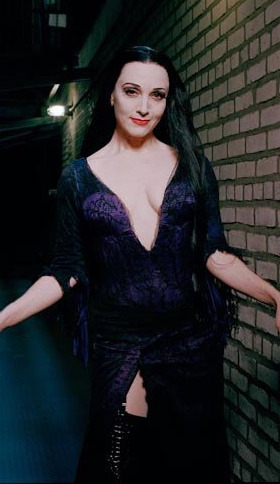


youtube
"Let me be abundantly clear. Bebe Neuwirth is my ultimate Diva. It may be stiff competition, but she wins the bracket of my heart every time. I would follow this woman to the end of the earth and back. I love everything about her from her cats, to her giggle, to her exquisite grey hair. I so admire any woman who chooses to age gracefully and without resentment, and Bebe's really settled into this adorable cozy old cat lady life. Back in the day, it was all stiletto heels and tight little black dresses and yes, that was very sexy. But now she's enjoying the comforts of flat sturdy boots, massive sweaters with cute little cats on them, glasses on chains, and divine grey hair. Gorgeous, yes. Talented, fuck yes. This woman has music in her bones and not even three hip surgeries can steal it away. I love her."
"Oh, Bebe Neuwirth? Love of my life, champion of my soul? Her legs are simply to die for. Not convinced? Search up When Velma Takes the Stand on YouTube and feast your eyes. You’ll be watching clips of her entire Broadway career next, trust me. She is truly a powerhouse of a woman, and one of Bob Fosse’s greatest interpreters." Propaganda submitted by anon "V"



youtube
"The pandemic robbed us of many things, but for our purposes here, the greatest loss to theatre was the revival of Who's Afraid of Virginia Woolf starring Laurie Metcalf. During the dinner scene, so I'm told by the gays on twitter, she came out in a sheer white blouse and black bra, and I am devastated we didn't get her unhinged Martha. She would have done Uta Hagen and Elaine Stritch proud."
Bonus poll in the tags/comments: Tell me who you think wins in a fight? Lilith from Cheers/Frasier, or Jackie from Rosanne. If you're too young to know what I'm talking about, what are you doing here?
#broadwaydivastournament#broadway divas#broadway#theatre#tournament poll#bebe neuwirth#laurie metcalf#round 1c#this poll is designed to hurt everyone old enough to have watched 80s/90s sitcoms#funnily enough both characters were heavily queercoded so i think they should just date each other wouldn't that be fun? (or disastrous)
34 notes
·
View notes
Text







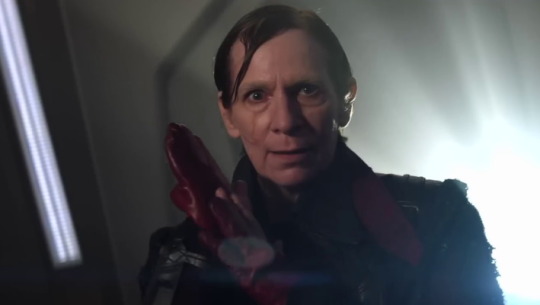


Female Sociopaths in Popular Media (Part 55)
Go here for Part 1. It provides an explanation for this list. Also, check out the master list which includes analyses of all the included characters. (Some analyses still may not be completed as of yet.) If this is the first part you’ve seen, reblog one of those two posts. Otherwise, feel free to reblog this one.
Sorry for being away for so long, but I'm back with my usual contribution to International Women's Day. Like always, I'm bringing in more sociopathic characters for your perusal. I'll be posting a bunch of female sociopath profiles this month (at least one a day from now until the end of the month). After that, I'll be ready to explain my absence and where this blog will be going after this month.
Pictured above:
Yuri[1] (played by Chanya McClory) from Girl from Nowhere (2018-present[2])
Catherine "Cathy" Ward (voiced by Mariya Tse (JP) and Jamie Marchi (EN)) from Angels of Death (2015) and its manga (2015-2020) and 2018 anime adaptations
the Doll Woman from Chainsaw Man Part 1 (2018-2020)
Manaka Sajyou (voiced by Aki Toyosaki) from Fate/Prototype (2011) and Fate/Prototype: Fragments of Sky Silver (2014-2017)
Khan Maykr (voiced by Nika Futterman) from DOOM Eternal (2020)
Lord Tokaguwa Harusada in Ōoku: The Inner Chambers (2004-2020)
Dee aka "Alpha" (played by Samantha Morton) from The Walking Dead TV series (2010-2022)
Captain Vadic[3] (played by Amanda Plummer) from Star Trek: Picard (2020-present[2])
Ren Pingsheng[4] from I'm More Dangerous Than You (2021-2022)
Emma Coleman[5] (played by Savisara Leela Yett) from The Woman in the House across the Street from the Girl in the Window (2022)
[1] Thanks to @nannoselliot for recommending this one. [2] Valid as of early March 2023. [3] Thanks to @donovaneagle2098 for recommending this one. [4] Thanks to @rickyriddle for recommending this one. [5] Major spoilers associated with this one.
If you wanna help me with this list, you can fact-check my profiles on the master list. I haven’t seen a lot of the things that these characters come from, so I don’t have a lot of firsthand knowledge. If you have seen/played/read any of the works that I have included, look through the profiles and see if there are any inaccuracies I need to edit.
Once I get a better flow of releasing new profiles, you suggest some characters for me to include on the list by leaving a comment on any of the posts, sending an ask, or messaging me. You’ll be credited for helping me when I include them in the gallery post. If you don’t want to be credited, just ask and I’ll leave your name off the post.
#International Women's Day#Yuri Girl from Nowhere#Chanya McClory#Khan Maykr#Santa Claus CSM#Vadic#Alpha TWD#Manaka Sajyou#Cathy Ward#Emma Coleman#Ren Pingsheng#Tokaguwa Harusada#Amanda Plummer#Savisara Leela Yett#Samantha Morton#sociopath
48 notes
·
View notes
Link
0 notes
Text
Richard Sherman (1928-2024)
Richard Sherman (1928-2024)Best Sheet Music download from our Library.List of worksPlease, subscribe to our Library. Thank you!Disney legend Richard Sherman, songwriter of ‘Mary Poppins’ and ‘It’s a Small World,’ dies at 95
Richard Sherman (1928-2024)
Richard Morton Sherman (June 12, 1928 – May 25, 2024) was an American songwriter who specialized in musical films with his brother Robert B. Sherman. According to the official Walt Disney Company website and independent fact-checkers, "The Sherman Brothers were responsible for more motion picture musical song scores than any other songwriting team in film history."

Some of the Sherman Brothers' best known songs were incorporated into live action and animation musical films including Mary Poppins, The Happiest Millionaire, The Sword in the Stone, The Jungle Book, The Many Adventures of Winnie the Pooh, Chitty Chitty Bang Bang, Snoopy Come Home, Bedknobs and Broomsticks, The Slipper and the Rose, and Charlotte's Web. Their most well known work is "It's a Small World (After All)", written for the theme park attraction of the same name. According to Time, it may be the most publicly performed song in history. List of works Major film scores The Parent Trap (1961) Big Red (1962) In Search of the Castaways (1962) Summer Magic (1963) The Sword in the Stone (1963) Mary Poppins (1964) Follow Me, Boys! (1966) The Happiest Millionaire (1967) The Jungle Book (1967) The One and Only, Genuine, Original Family Band (1968) Chitty Chitty Bang Bang (1968) The Aristocats (1970) Bedknobs and Broomsticks (1971) Snoopy, Come Home (1972) Charlotte's Web (1973) The Adventures of Huckleberry Finn (1974) The Slipper and the Rose (1976) The Many Adventures of Winnie the Pooh (1977) The Magic of Lassie (1978) Magic Journeys (1982) Winnie the Pooh and a Day for Eeyore (1983) Little Nemo: Adventures in Slumberland (1992) Winnie the Pooh: Seasons of Giving (1999) The Tigger Movie (2000) Iron Man 2 (2010) (Composed the song "Make Way For Tomorrow Today". Instrumental versions were later featured in Captain America: The First Avenger and Avengers: Endgame) The Jungle Book (2016) Christopher Robin (2018) Motion picture screenplays A Symposium on Popular Songs, 1962 Mary Poppins, 1964 (*treatment only), The Adventures of Tom Sawyer, 1973 The Adventures of Huckleberry Finn, 1974 The Slipper and the Rose, 1976 The Magic of Lassie, 1978 Ferdinand the Bull, 1986 (*TV screenplay) Stage musicals Victory Canteen, 1971 (Ivar Theatre, L.A.) Over Here!, 1974 (Broadway, NY) Dawgs, 1983 (Variety Arts Center, L.A.) Busker Alley, 1995 (U.S. Tour) Chitty Chitty Bang Bang, 2002 (London) Mary Poppins, 2004 (London) On the Record, 2004-5 (U.S. Tour) Chitty Chitty Bang Bang, 2005 (Broadway, NY) Chitty Chitty Bang Bang, 2005 (UK Tour) Busker Alley, 2006 (Broadway, NY - *one night only) Mary Poppins, 2006 (Broadway, NY) Chitty Chitty Bang Bang, 2007 (Singapore) Mary Poppins, 2008 (UK Tour) Chitty Chitty Bang Bang, 2008 (Second UK Tour) Mary Poppins, 2008 (Stockholm) Mary Poppins, 2009 (US Tour) Mary Poppins, 2009 (Copenhagen) Mary Poppins, 2009 (Shanghai) Mary Poppins, 2010 (Australia) Mary Poppins, 2009 (South Africa) Mary Poppins, 2009 (The Hague) Mary Poppins, 2009 (Helsinki) Mary Poppins, 2012 (Budapest) Summer Magic, 2012 (Morristown, Tennessee) The Jungle Book, 2013 (Chicago, Illinois) The Jungle Book, 2013 (Boston, Massachusetts) A Spoonful of Sherman, 2014 (London) Mary Poppins, 2015 (Vienna, Austria) Chitty Chitty Bang Bang, 2015–16 (UK Tour) Mary Poppins, 2015–16 (UK Tour) A Spoonful of Sherman, 2017 (London) A Spoonful of Sherman, 2018 (UK/Ireland Tour) A Spoonful of Sherman, 2019 (San Jose, CA) A Spoonful of Sherman, 2019 (Singapore) Mary Poppins, 2019 (London) Bedknobs and Broomsticks, 2021 (UK Tour) Theme park songs There's a Great Big Beautiful Tomorrow for Carousel of Progress The Best Time of Your Life for Carousel of Progress Miracles from Molecules for Adventure Thru Inner Space One Little Spark for Journey into Imagination Magic Journeys for Magic Journeys The Many Adventures of Winnie the Pooh Pooh's Hunny Hunt it's a small world (after all) for the 1964 New York World's Fair attraction, Pepsi Presents WALT DISNEY'S "it's a small world" – a Salute to UNICEF and the World's Children, then adapted to each Disney Park installation of "It's a Small World" The Astuter Computer Revue for the 1982 premiere of the CommuniCore Exhibit at EPCOT. Magic Highways for Rocket Rods Making Memories for Magic Journeys The Tiki, Tiki, Tiki Room for Walt Disney's Enchanted Tiki Room We Meet the World with Love and Meet the World for the same exhibit in Tokyo Disneyland Kiss Goodnight exit music from Disneyland Forever for Disneyland's 60th Anniversary Nighttime Fireworks Spectacular show, originally sung by Ashley Brown.
Disney legend Richard Sherman, songwriter of ‘Mary Poppins’ and ‘It’s a Small World,’ dies at 95
https://www.youtube.com/watch?v=X-izLHwieo4 Read the full article
#SMLPDF#noten#partitura#sheetmusicdownload#sheetmusicscoredownloadpartiturapartitionspartitinoten楽譜망할음악ноты
0 notes
Text

Shanul Sharma sings the full spectrum, bringing passion to every piece he performs. (ABC News: Sharon Gordon / Supplied: Shanul Sharma)

Shanul says the vocal skills he gained from heavy metal help his opera. (Supplied: Shanul Sharma)

Shanul says he's fallen in love with the "stakes" of opera singing. (Supplied: David Ng)
Shanul used to sing in a heavy metal band. He's now dazzling audiences at the opera
Opera singer Shanul Sharma's voice has been labelled dazzling and resplendent by critics, but classical music wasn't his first choice.
The tenor's first steps onto the stage were surrounded by electric guitars and banging heads.
Initially the lead singer of a heavy metal band, Shanul made the switch in 2012.
While the two genres may seem worlds apart, he says metal and opera share a lot of similarities.
By Monty Jacka and Sally Bryant
ABC - Make Me Feel Good
ABC News - 18 November, 2023
Photos © 2023 Shanul Sharma
•
•
SEE also: https://www.shanul.com.au/
•
•
YouTube video >> Operabase: Shanul Sharma sings Mitridate, re di Ponto (Mithridates, King of Pontus), K. 87 (74a), an opera seria in three acts by the young Wolfgang Amadeus Mozart, 1770. (Released July 30, 2022 / 4mins.+57secs.):
Tenor: Shanul Sharma
Pianoforte: Andrea Katz
Recorded 27-06-2022 at Horti Hall, Melbourne, Australia.
•
•

Shanul Sharma in the role of Mahatma Gandhi, in a 2023 production of Satyagraha by Philip Glass, produced by Opera Australia.
YouTube video: Satyagraha by Philip Glass, produced by New York Opera Orchestra and Chorus, Conducted by Christopher Keene (Released 19 September 2015 / 14mins.+45secs.)
SEE: Shanul Sharma in the role of Mahatma Ghandi in Satyagraha by Philip Glass, produced by Opera Australia, Director Andy Morton, Conductor Tahu Matheson, 2023:
#Arts culture & entertainment#Music & musicians#Opera singer Shanul Sharma#Opera#‘Satyagraha’ opera by Philip Glsss#Opera Australia#Heavy Metal#YouTube
0 notes
Text
Days Of Steam 008: Icarus Redux
(Released July 11, 2023)
Restrained freakout sonics and subcranial rhythms from @icarus-redux — “earth-moving kicks, baleful, eyes-dilated synths, and rough, mostly unsampled breakbeats. Fog machine bathing all as one.” Inspired as an artist by a mixed bag of artists and theorists that cast light on the darkness - Fisher, Graeber, Preciado, Shadow, Sprinkles, Tiqqun, Weatherall - this mix is one of the first I’ve heard that approaches AI-assisted technologies (demuxing, polyrhythmic mixing, etc) in a way that reminds me of early cut-and-paste techniques or Richie Hawtin’s Decks x EFX mixes that reassemble contexts on a micro-level, not just layering tracks over each other but reconstructing them, and here it’s far more subtle. It’s enticing and unnerving to me but such is the effect of the dawn of a new form of technology that has the principle for use and abuse. Here it’s done to only positive effect, again highlighting the spaces between the notes, the snatches of memory that flit through your brain. A lot of the tracks from the early 2010s are records I remember hearing and playing when I lived in Leeds, which I had associated with a very different scene that I naively believed at the time would never truly take off Stateside. At the same time, Disclosure were getting big then and I thought the US would pass them over. From downloading italo and house rips off of Bicep's old blog to seeing them headline warehouses in Brooklyn that charge $40+ admission. Mais je divague...
Bianca Scout - Kingdom [First Terrace, 2022] Herbert - Deeper (Basic Soul Unit Remix) [Curle, 2016] T++ - Dig [Honest Jons, 2010] Avatism - Self Control [Vakant, 2017] Basic Soul Unit - Jak'd Freq (A Made Up Sound - Puur Natuur Mix) [Crème Organization, 2010] Ayln - Victim [Nous, 2018] Tenebre - Axe Nord-Sud [WNCL Recordings, 2018] Reckonwrong - Morton [Pinkman, 2015] Taraval - Bart's Sanctuary [Text, 2016] Blawan - Iddy [Hessle Audio, 2010] Martyn - Body Music [Dolly Dubs, 2018] Pugilist - Déjà Vu [Banoffee Pies, 2022] Ryan James Ford - Brixa Endt [SHUT, 2018] Shed - Lumber Fix TT [The Final Experiment, 2018] Private Press - Wetweird [Of Paradise White Label, 2022] Clark - Superscope [Warp, 2014] Andrea - Rainbow [Ilian Tape, 2015] Glaskin - Grey Lines [Hotflush, 2018]
#SoundCloud#Icarus Redux#Bianca Scout#Herbert#Basic Soul Unit#T++#Avatism#A Made Up Sound#Ayln#Tenebre#Reckonwrong#Taraval#Blawan#Martyn#Pugilist#Ryan James Ford#Shed#Private Press#Clark#Andrea#Glaskin#days of steam
0 notes
Text
WEEK 8: FACE FILTERS
Augmented Reality (AR)
Augmented Reality (AR) was developed by cinematographer - Morton Heilig in 1957. He developed a system to help viewers feel the realism of images, sounds, vibrations and smells.
Between here and now, there have been several advances in augmented reality, the most prominent of which are:
In the year 2000, Bruce Thomas created ARQuake, an outdoor mobile AR game.
ARToolkit (a design tool) was released in Adobe Flash in 2009.
In 2013, Google announced the open beta of Google Glass (a project with mixed results).
In 2015, Microsoft announced augmented reality compatibility and the HoloLens augmented reality device.
Social Media Filters
Personally, I divide Filters into two categories: Beauty filters and Background filters.
Beauty filters: filters used for retouching, highlighting, and makeup for the face and body.

Image 1: Example of beauty filter.
Background filters: filters used to edit the color, style, and perspective of the overall image.

Image 2: Example of background filter.
The process of creating filters is becoming progressively simpler owing to third-party software. Users may quickly and simply create their own filters based on their own ideas. For further information, please see the video tutorial below: https://vt.tiktok.com/ZS8TsUqbM/
Filter creation is supported by a number of programmes, including Picsart, Spark AR Studio, Effect House,...
For a number of reasons, Instagram users frequently utilise filters. The ability of filters to improve images' appearance and make them appear more visually appealing and beautiful is one of the main justifications.
In addition, filters can assist in hiding faults or abnormalities in photographs, such as blemishes or uneven lighting.
Additionally, using filters has become customary on social media, where many users feel under pressure to present visually stunning content and stay current with trends.
Gender and Filter
According to research, women are more prone than males to apply filters to their images, maybe in an effort to make themselves seem better or achieve a certain style. This can be as a result of social pressure on women to uphold certain beauty standards or portray certain images on social media. It's crucial to remember that gender is a complicated and varied feature that may have a range of effects on a person's behavior.
The Future of AR
Enhanced shopping experiences: Consumers can use augmented reality to preview how an item of apparel or accessory would appear on them before making a purchase, leading to better-informed purchasing decisions.
Virtual try-on: AR can be used to enable virtual try-ons of eyewear and cosmetics, allowing users to view in real time how various things would appear on their faces.
Interactive filters: AR filters can become more interactive, allowing users to interact with virtual items and characters in real time, creating more immersive and engaging social media experiences.
REFERENCES
Augmented reality – the past, the present and the future (2023) The Interaction Design Foundation. Interaction Design Foundation. Available at: https://www.interaction-design.org/literature/article/augmented-reality-the-past-the-present-and-the-future.
0 notes
Video
Morton Arboretum by Andi Marie Via Flickr:
Thinking of Spring
1 note
·
View note
Photo
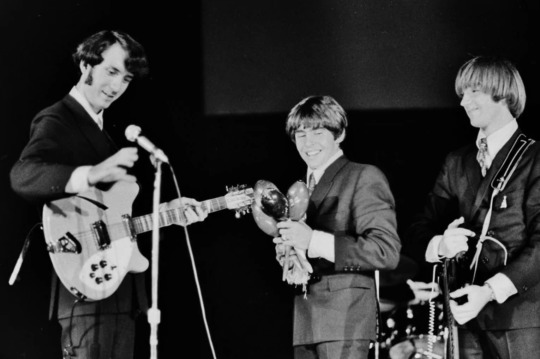









(Photo 1) Michael Nesmith, Davy Jones, and Peter Tork onstage in August 1967, photo by Tom Morton; (photos 4, 6 & 7) Peter taking photographs of Michael and Davy, published in Flip magazine, March 1968; (photo 5) Peter and Michael at the 2014 Monkees Convention, photo by Bobby Bank/WireImage.
“I have a great deal of respect for Mike as a musician and a songwriter. He’s very good. He could make it on his own easily. Also he’s one of the funniest people I’ve ever met. [...] Davy has a lot of guts. Internal fortitude if you prefer.” - Peter Tork, Flip, August 1967
“The first time I met Peter was at the Troubadour where he performed, long before the auditions. I’ve always liked his warmth and honesty. And he’s always been very kind to me. Both Davy and Peter have lived with us and Peter was always very considerate, helping with the dishes and all. [...] Christian liked all of them right from the first. He’s always so happy when any of the Monkees drops over. When Davy and Peter lived with us it was kind of a family atmosphere. They just all kind of pitched in — and even babysat for us!” - Phyllis Nesmith, Fave magazine, January 1968
“I remember staying at Mike’s house in Hollywood when we first started filming the series. It was the upper story of a two-story building on a little hillside. Mike’s wife, Phyllis, was wonderful. Mike and I laughed a lot and played music together. I remember that time very fondly.” - Peter Tork, When The Music Mattered (1984) (x)
“Looking back I have to say that Davy was the one I had the most feeling for, Micky was the one I had the most fun with, and Mike was the one I had the most respect for.” - Peter Tork, Monkeemania: The True Story of The Monkees (1997)
“The man was unique and a huge, huge talent. We’re not going to replace him. [...] [Davy] was such a little heartthrob. I don’t think people knew how bright and talented and gifted he was in all things. I’ve come to believe he was, in his own way, the smartest, most musically talented and best actor among us.” - Peter Tork, Boston Globe, May 16, 2013
“Basically with Michael we don’t ask [about touring with The Monkees]. If he says that he doesn’t want to do it, then he doesn’t want to do it. Nobody has very much influence on Michael in any case so there is hardly any point is us trying to cajole him into anything that he doesn’t want to do. We will miss Tex.” - Peter Tork, UK Music Reviews, May 28, 2015
“We dearly miss our dear departed brother; our brother in arms; the small one, now what’s his name, it will come to me in a minute (laughter). We called him the Manchester Cowboy. Davy had a love affair; a brief flirtation with country music for a little while and we called him the Manchester Cowboy from that, and it stuck. It’s all fond memories.” - Peter Tork, UK Music Reviews, May 28, 2015
“The first time I heard that [’Me and Magdalena’] I heard just Michael’s lead vocal without Micky’s harmony part, and I was really struck. Michael has tapped some new, personal emotional depth within himself that I never expected to hear on record. [...] I only now have, in the last couple of years, come to understand how smart and good-hearted Davy Jones could be. I did not have the skills to notice that, even though I was drawn to it without knowing exactly why. But I certainly did not have the first clue of how to encourage all of the good stuff from Davy that I loved. I wish I could have known how to do it — and he might still be with us, even.” - Peter Tork, Las Vegas Weekly, September 14, 2016
“Mike and I have been back and forth with the emails […] I bore him no ill-will. I have a lot of respect and admiration and some affection for Mike. And I’m glad to be back in touch with him.” - Peter Tork, interview with Iain Lee, 2012
"What I made the decision to do [in the last year or so of Peter’s life] was to stand by his side, be a friend and give him as good a send-off as I know how to give from this plane of existence.” - Michael Nesmith, The Courier Mail, April 10, 2019
"I will miss [Peter] — a brother in arms. Take flight my Brother.” - Michael Nesmith, Facebook, February 2019 (x)
#Davy Jones#David Jones#Michael Nesmith#Mike Nesmith#Peter Tork#The Monkees#Monkees#1960s#Tork quotes#Capricorn and Jones birthday remembrance#60s Tork#<3#bearded Peter#long read#Tork performances#😭#'brother in arms' a recurring statement#Peter and Davy#Peter and Michael#1967#1986#1989#2014#2016#2012#2019#Flip Magazine#Fave Magazine#When The Music Mattered#Monkeemania: The True Story of The Monkees
148 notes
·
View notes
Text
The Morton Family

Michael Beveridge Morton was born Aug 24 1952.
Jeanine Dorothy Cox was born July 12 1960.
Mike and Jeanine married June 5 1982. They had 12 children.
1. Catherine (Katie) Esther was born April 4 1983
2. Michael Beveridge was born June 6 1984
3. William (Cleveland) was born Aug 27 1986
4. Joseph (Westley) was born Mar 8 1988
5. Dorothy Jeanine was born Feb 19 1990
6. Adeline Grace was born July 15 1991
7. Martha Harriett was born Jan 3 1993
8. Andrew Tully was born Feb 2 1995
9. Samuel Quentin was born Dec 2 1996
10. John Wright was born Oct 5 1998
11. Edwin Orgen was born Mar 19 2001
12. Paul Warren was born Jul 26 2003
00. Baby Morton Oct 2006 miscarriage
.
Katie married Bret (Alan) Smith April 8 2006 but divorced July 2016
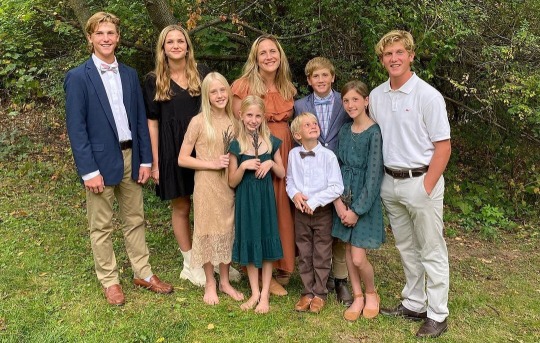
1. Brian Alan Jan 15 2007
2. Ronald Michael Jan 9 2008
3. Catherine Esther May 17 2009
4. Wallace Johnson Aug 16 2010
5. Anna Grace Oct 25 2011
6. Elisabeth Rose Jan 29 2013
7. Dorothy Jaqueline Oct 23 2014
8. Jackson Lee July 30 2016
A. Brian is dating Hanna Coppock

.
B. Ron is dating Claire Williford

.
Mike married Kressant Amanda Smith Sept 2 2006
1. Michael Beveridge III June 26 2007
2. Carlos Phineas July 31 2008
3. Jonathan DeWitt Nov 15 2009
4. Isabella Grace April 25 2011
5. Byron Zika Oct 4 2012
6. Fletcher Harold June 18 2014
7. ElRoy DeKalb Nov 6 2016
8. Varina Brooke Aug 6 2018
.
Cleveland married Lise Marie Kendall Dec 3 2011

1. William (Liam) Cleveland Sept 26 2012
2. Kendall Westley Jan 15 2014
3. Carolina Elise Feb 4 2016
4. Joshua Elliot July 1 2018
5. Elijah Seth Mar 25 2020
6. Gideon Eleazer July 17th 2022
7. Thomas Ezekiel Nov 26 2024
.
Westley married Rachel Lea Smith Sept 8 2007

1. Joseph (Joey) Westley May 5 2008
2. William Stone Sept 9 2009
00. Timothy Sept 2010 miscarriage
3. Ariana Grace Mar 19 2012
4. Luke Anthony July 13 2013
5. Olivia Brooke Mar 8 2015
6. Levi Andreas Mar 28 2017
7. Manuel Zeon April 23 2019
8. Gabriel Lorenzo April 24 2024
.
Dorothy married Noah Edwin Sanders July 17 2010
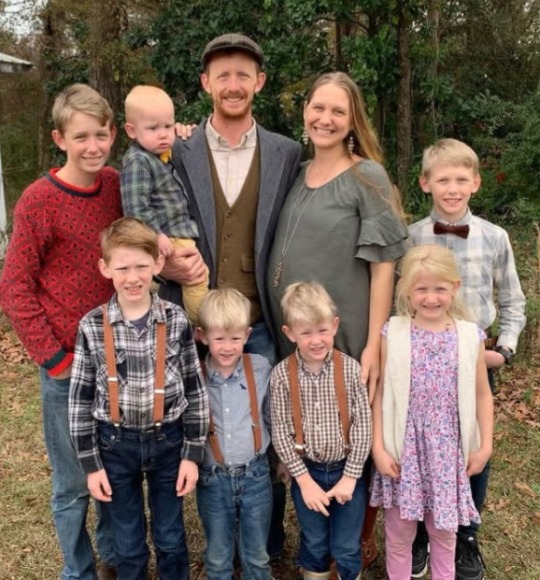
1. Enoch Timothy Aug 16 2011
2. Patrick Oldreive Dec 9 2013
3. Edwin Gianavel Feb 25 2016
4. Brielle Jeanine Sept 28 2018
5. Carver Deall June 18 2020
6. Booker Van June 18 2020
7. Dietrich Lee June 23 2023
8. Baby Sanders due Feb 2025
.
Adeline married Michael Glen Holloway Sept 12 2020
1. Anthony Glen July 29 2021
2. Adeline Jean Jan 23 2023
3. Ezra Michael April 24 2024
.
Martha married Tayte Russell Alexander Oct 25 2014, they have since separated as of Oct 2023
1. Alexandria Lea Sept 24 2015
.
Andrew married Kennedy Kayla Marie Decker Sept 26 2015
1. Mia Jayden July 9 2016
2. Valerie Mayv Aug 3 2018
3. Naida Drew Feb 18 2020
4. Hamish Locke Oct 14 2021
5. John Davis Aug 13 2024
.
Sam married Alyssa Rose Campana Mar 26 2016

1. Norah Rose Dec 28 2016
2. Victoria Marie Dec 31 2017
3. Audrey Kress Dec 5 2018
4. Samuel (Quentin) Mar 1 2020
5. Claire Elizabeth June 6 2021
6. Charlotte Gabrielle Jan 26 2023
7. Baby Morton due 2024
.
John married Campbell Conley Roberts Nov 3 2018

1. Buchanan Wright April 12 2021
2. Lillian Scout April 20 2023
.
Edwin married Francessca Tuggle June 4 2022

1. Abram Orgen March 27 2023
2. Tavia April 21 2024
.
Paul married Helena Mucciolo Sept 21 2023
1. Girl July 2024
#family intros#morton family#kendall family#sanders family#holloway family#alexander family#decker family#campana family#roberts family
8 notes
·
View notes
Text
Broadway Divas Tournament: Round 2B


Lea Salonga (1971) “LEA SALONGA (Co-Producer) Broadway producing debut. As a performer on Broadway: Miss Saigon (Tony, Olivier, Drama Desk, and OCC awards), Once On This Island, Allegiance, Les Misérables, Flower Drum Song. Lea has toured globally as a concert artist, released multiple solo albums and was honored as a Time100 Impact Award recipient in 2002.” – Playbill bio from Here Lies Love, August 2023.
NaTasha Yvette Williams “NATASHA YVETTE WILLIAMS (Matron “Mama” Morton) is delighted to join Chicago! Last seen in Show Boat (Queenie), NY Philharmonic. Broadway: A Night with Jannis Joplin (Aretha, Joplinaire), The Gershwins’ Porgy and Bess (Mariah), The Color Purple (Sofia). Featured vocalist/concerts: Carnegie Hall (Irving Berlin), Avery Fisher Hall (Ragtime), Indianapolis Symphony, Baltimore Symphony, Naples Philharmonic, Ottawa Symphony, just to name a few. NaTasha is also a recording artist. Love to Gregory and the little Lees! www.natashayvettewilliams.com” – Playbill bio from Chicago, January 2015.
NEW PROPAGANDA AND MEDIA UNDER CUT: ALL POLLS HERE


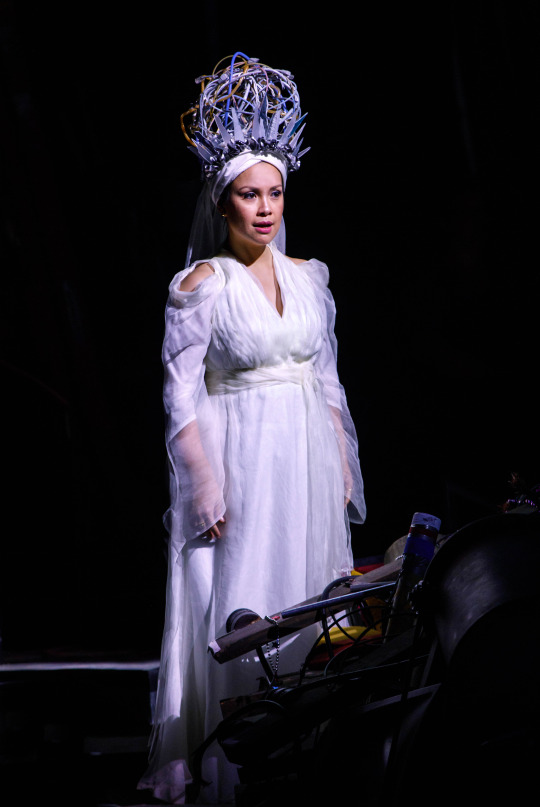
youtube
"Back from the dead, Lea Salonga lives to fight another day. And the tournament once more has an Asian on the docket. I may have been Team Christine last round, but now I shall embrace my Southeast Asian homeland."

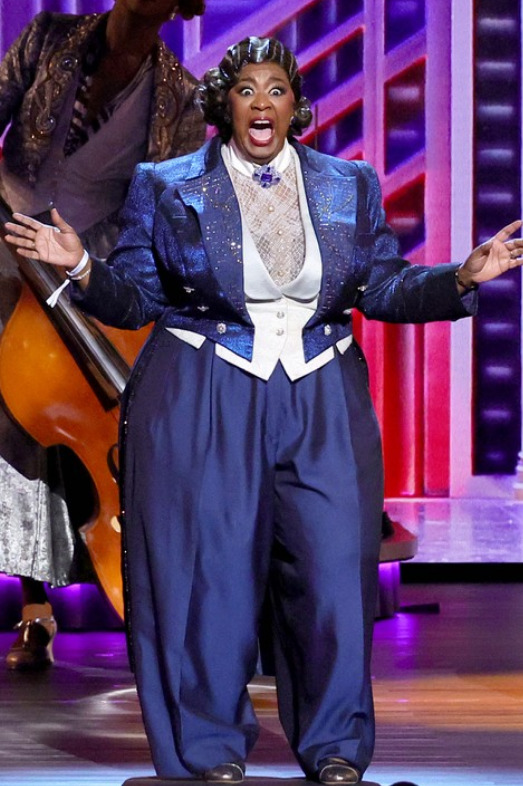

"Grammy-winner NaTasha Yvette Williams, damn that sounds good. It's what she deserves. Truly, she was the reason I made it through that musical alive."
#broadwaydivastournament#broadway#tournament poll#broadway divas#musical theatre#lea salonga#natasha yvette williams#round 2b
11 notes
·
View notes
Text
Miraculous Ladybug x Identity V: The Oletus manor diary of a ladybug: Chapter 4
Chapter 3 Chapter 5
Prompt concept
Warning : English is not my first language so sorry if it’s confusing !
Warning 2 : This fanfic content salt if you don’t like don’t read !
Hey everyone! ^^ So I kinda neglected this story for a while, so here’s for you a double update! ^^
So let’s begin with the first part of this double update: the chapter 4, have a good reading! ^^
-------------------------------------------------------
22/04/2015, Oletus manor :
Today mademoiselle Dyer told me since I seem to had more energy than yesterday it should doing me good to get up to had breakfast with her and the rest of the manor's tendants to ̎ exercice ̎ a little and to meet the rest of the people with who I will live for those next two weeks.
When we get to what seemed to be the dinning room I was welcomed by the sight of many people... A LOT of people.
And those people were to say, ̎ original ̎, and the sight of the big clown and the lizard man comfirmed me that they were quite real and not allusionations from my feverish mind.
So among all the people I met during breakfast there was :
The ̎ survivors ̎ with :
-Mademoiselle Emily Dyer aka ̎ Doctor ̎
-Mademoiselle Emma Woods aka ̎ Gardener ̎
-Monsieur Freddy Riley aka ̎ Lawyer ̎
-Monsieur Kreacher Pierson aka ̎ Thief ̎
-Monsieur Servais Le Roy aka ̎ Magician ̎
-Monsieur Kurt Frank aka ̎ Explorer ̎
-Monsieur Naib Subedar aka ̎ Mercenary ̎
-Mademoiselle Martha Behamfil aka ̎ Coordinator ̎
-Mademoiselle Tracy Reznik aka ̎ Mecanic ̎
-Monsieur William Ellis aka ̎ Forward ̎
-Mademoiselle Helena Adams aka ̎ The mind's eye ̎
-Mademoiselle Fiona Gilman aka ̎ Priestress ̎
-Mademoiselle Vera Nair aka ̎ Perfumer ̎
-Monsieur Kevin Ayuso aka ̎ Cowboy ̎
-Mademoiselle Margaretha Zelle aka ̎ Female dancer ̎
-Monsieur Eli Clark aka ̎ Seer ̎
-Monsieur Aesop Carl aka ̎ Embalmer ̎
-Monsieur Norton Campbell aka ̎ Prospector ̎
-Mademoiselle Patricia Dorval aka ̎ Enchantress ̎
-Monsieur Murro aka ̎ Wilding ̎
-Monsieur Mike Morton aka ̎ Acrobat ̎
-Monsieur Jose Baden aka ̎ First Officer ̎
-Mademoiselle Demi Bourbon aka ̎ Bardmaid ̎
-Monsieur Victor Grantz aka ̎ Postman ̎
-Monsieur Andrew Kreiss aka ̎ Gravekeeper ̎
-Monsieur Luca Balsa aka ̎ Prisoner ̎
-Monsieur Edgar Valden aka ̎ Painter ̎
And Monsieur... ̎ Lucky Guy ̎? (Is thas his real name?)
And the ̎ Hunters ̎ with :
-Monsieur Leo Beck aka ̎ Hell Ember ̎
-Monsieur Joker aka ̎ Smiley Face ̎
-Monsieur Jack aka ̎ The Reaper ̎
-Monsieur Bane Perez aka ̎ Gamekeeper ̎
-Mademoiselle Violetta aka ̎ Soul Weaver ̎
-Madame Michiko aka ̎ Geisha ̎
-Monsieur Hastur aka ̎ The Feaster ̎
-Monsieur Wu Chang but also know as... Messieurs Xie Bi'an & Fan Wujiu ? aka ̎ Black and White guards ̎ (Tiki seemed very agitated at those names, does she know rhose men ? I should ask her later)
-Monsieur Joseph Desaulniers aka ̎ Photographer ̎
-Monsieur Burke Lapadula aka ̎ Mad Eyes ̎
-Miss Yidhra aka ̎ Dream Witch ̎ and a little girl named ̎ Follower ̎ ?
-Robbie White aka ̎ Axe Boy ̎
-Monsieur Luchino Diruse aka ̎ Evil Reptilian ̎
-Mademoiselle Mary aka ̎ Bloody Queen ̎ (Somehow this name and this ̎ title ̎ are familiar)
-Bonbon aka ̎ Guard 26 ̎
-Mademoiselle Ann aka ̎ Disciple ̎
And Monsieur Antonio aka ̎ Violonist ̎
I was surprised to recognized some of the people present, the few faces I recognized are people I met at least once ever since me and my class arrived at Eurydice.
(I know I should rather be surprised-no scratch that SHOCKED to be actually surronded by such... unique persons ? Especially since some of them are apparently literal ghosts and others supernatural beings, and a robot... I may have been dealing with Hawkmoth's evil antics for too long for not even batting an eye to wierd supernatural shenaningans... and it's propably also because of the fever...)
Anyway, I did recognized some faces, like, of course docteur Dyer, who's normally doctor at the hospital of Eurydice and who I met after I get to to the hospital to get treated due to an accident after having being left behind by the class at the hotel when we were supposed to visit the town's museum.
There was also monsieur Carl who was the man who helped me to go to the hospital where I met docteur Dyer after my accident.
I also recognized monsieur Grantz, who I saw delivering mails across the town times to times, mademoiselle Bourbon, who work in a cafee which I have gone to with my class once and mademoiselle Woods, who take care of the town's park's gardens.
Heck, I'm even pretty sure that messieurs Lapadula and Desaulniers are the same messieurs Lapadula and Desaulniers who work at Eurydice's museum as tour guides for the technology section and photography section.
I... really don't know what to think about all this...
I spent the rest of breakfast to get to know them all, some were actually nice and welcoming, or at least civil like docteur Dyer, mademoiselle Woods, monsieur Carl, Robbie or monsieur Clark, some others were just going on with their breakfast or minding their own business.
To be honnest, I don't really mind it, I know I shouldn't judge people I just met but... Some of them really give me a chilling feeling, as if to tell me that I should stay away from them as much as possible.
I also noticed monsieur Wu Chang throwing glaces at me times to times, but, there was also monsieur Hastur who was staring at me during the whole meal with an intense gaze, as if he noticed something about me.(pleasedon'ttellmehenoticedTikkipleasedon'ttellmehenoticedTikkiPLEASEDON'TTELLMEHENOTICEDTIKKI!)
After that, and saying polite goodbyes to the manor's habitants, I immediatly go back to my room to rest, doctor's orders, the worrying feeling sot going away.
Maybe I should be carefoul at least around some of those people, just to be safe, after all you never know what people could do at the moments you expect the least, like with my classmates...
…
Anyway, speaking of my class, I wonder what they're doing right now ! Did mademoiselle Bustier noticed i'm missing ? Nha, knowing her either she noticed one or two days later or Lila lied to her about where I was and believed her, as ussual, and someone else noticed something wasn't normal and reported my disparition.
But still, I can't help but wonder how things are going for them at the hotel...
—————————————–
TAG LIST :( a reblog will get you a place in the tag list! ^^)
@diana-berry , @doll246
#ml salt#identity v#miraculous ladybug#ml salt fic#ml fanfic#marinette dupain cheng#survivors#hunters#Tikki#caline bustier#miraculous class#lila rossi#oletus manor#diary entries#class salt#bustier salt#caline bustier salt#marinette deserves better
27 notes
·
View notes
Text
Crooked Timber's Ministry for the Future Seminar
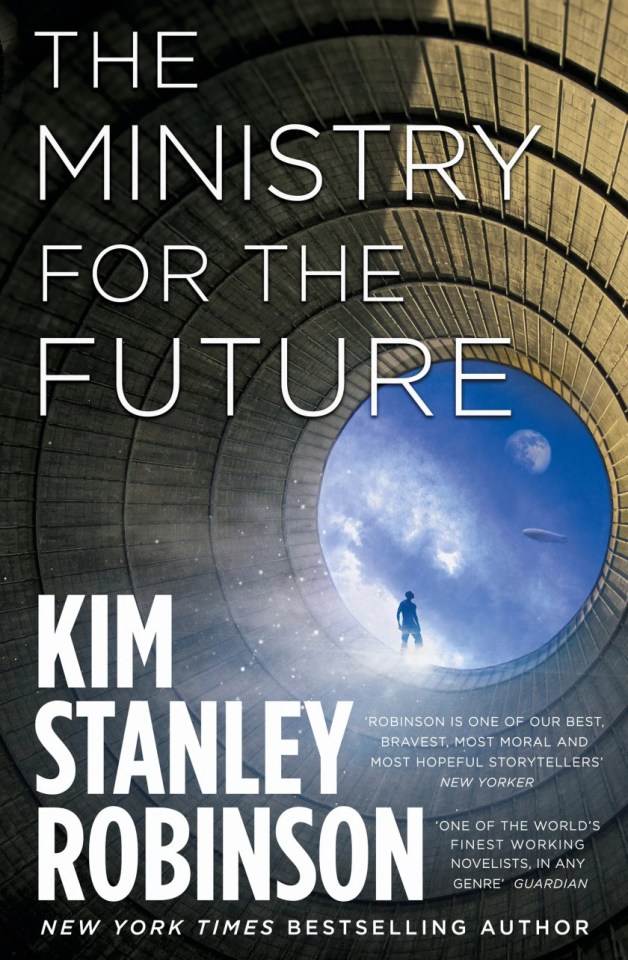
Kim Stanley Robinson's 2020 novel "The Ministry for the Future," is a fierce imaginative work. Robinson doesn't just depict a future beyond the climate emergency and capitalism itself, he depicts the specific, wrenching transition that takes us there.
https://www.orbitbooks.net/orbit-excerpts/the-ministry-for-the-future/
As I wrote in my review, the (variously attributed) maxim "It is easier to imagine the end of the world than the end of capitalism," isn't quite right. Imagining postcapitalism is an easy lift, but imagining the path to that world is *very* hard.
https://pluralistic.net/2020/12/03/ministry-for-the-future/#ksr
Robinson didn't leap into this project - he's been working up to it for literally decades, at least since the publication of the "Three California" books, which include one of the most uplifting novels I've ever read, PACIFIC EDGE:
https://memex.craphound.com/2015/01/15/pacific-edge-the-most-uplifting-novel-in-my-library/
Meanwhile, his 2312/Aurora/New York 2140/Red Moon novels constitute a kind of rangefinding exercise, starting 300 years the future and then walking his projection backwards to find a plausible route to get there.
https://memex.craphound.com/2017/03/18/new-york-2140-kim-stanley-robinson-dreams-vivid-about-weathering-climate-crisis/
But all these brilliant novels really seem to be warmup exercises for the main event, The Ministry for the Future, which depicts the intermeshed systems of economics, politics, geoengineering, streetfighting and tragedy that might rescue us from dying in our own waste-gases.
It's urgent, frightening and hopeful, raising as many questions as it answers.
These questions are now taken up in one of Crooked Timber's "seminars": a series of interdisciplinary essays about the book, culminating in the author's response.
https://crookedtimber.org/2021/05/03/the-ministry-for-the-future-seminar/
The first of these essays comes from Maria Farrell: "What is Ours is Only Ours to Give," about the digital technology at the core of TMFTF, namely blockchain and independent social media. Farrell is characteristically incisive on these elements.
https://crookedtimber.org/2021/05/04/what-is-ours-is-only-ours-to-give/
Her thoughts here tie back to her notion of the "prodigal tech bro," and how we should treat the tech industry's claims of genius with skepticism - even when those claims are cloaked in confessions of being an EVIL genius.
https://crookedtimber.org/2020/09/23/story-ate-the-world-im-biting-back/
The next essay is Oliver Morton's, digging into the solar geoengineering in TMFTF, and the "sustained contradiction" such an effort might produce - relieving the urgency of addressing carbon production and accumulating new policy debt in the process.
https://crookedtimber.org/2021/05/05/on-solar-geoengineering-and-kim-stanley-robinson/
Morton's a very good choice for this role: his 2016 book on geoengineering, "The Planet Remade," remains one of the best technological, economic and political overviews of the subject:
https://memex.craphound.com/2016/05/04/the-planet-remade-frank-clear-eyed-book-on-geoengineering-climate-disaster-humanitys-future/
Next is Jessica Green's "Can the World’s Bankers Really Save the Climate?" which drills into Robinson's fictional carbon markets, where central bankers are pressed into service to save the planet in an unjust (but rapid and necessary) compromise.
https://crookedtimber.org/2021/05/06/can-the-worlds-bankers-really-save-the-climate/
Green's an expert on climate and finance, so she's as good at spotting the cards that Robinson palms here as Farrell is with tech. Green credits Robinson with identifying the "true sources" of climate obstruction, but thinks he's missed the mark on how to deal with them.
Next is the Roosevelt Institute's Todd Tucker with "Ministry for Your Future Soul": praise for KSR's depiction of the scientific process, scientists, policy wonks, and the progress of policy. Tucker calls Robinson a "Gramscian science fictionologist."
https://crookedtimber.org/2021/05/07/ministry-for-your-future-soul/
Robinson's "dynamic imagination...makes the book valuable to policy nerds" because "fiction can inform planning," specifically through that exercise of starting with the outcome we want and then working backwards to imagine the steps we need to get there.
This "backcasting" method has many and varied adherents. It's the method that Anonymous used to create its notorious ops, as documented in Biella Coleman's 2014 book on the ensemble:
https://www.spectator.co.uk/article/the-anonymous-ghost-in-the-machine
But it's also the method that Amazon uses for new product decisions: starting by writing the press-release announcement and then working backwards to sell the org on developing the product to go with the press-release:
https://www.inc.com/justin-bariso/amazon-uses-a-secret-process-for-launching-new-ideas-and-it-can-transform-way-you-work.html
Next is Belle Waring's "Sudden Tempest of Ultimate Summer," which goes straight for the political violence in TMFTF, and KSR's seeming discomfort with this violence, coupled with his evident belief in its necessity.
https://crookedtimber.org/2021/05/10/the-sudden-tempest-of-ultimate-summer/
As Waring points out, alongside all the nonviolent tactics Robinson depicts, there is a lot of (mostly offstage) violence - and when that violence is onstage Robinson pivots away from it, subjecting the Davos hostages to Powerpoint presentations instead of a firing squad.
Waring also grapples with the intimate, gendered role that violence plays in the book - the relationship between heroine Mary Murphy and the traumatized antihero Frank May, who holds her hostage, and whom Murphy subsequently dedicates herself to.
The next installment - Half the Earth? - comes from John Quiggin, a trained agricultural economist who delves into Robinson's depiction of a successful "Half Earth" transition in which humans surrender half our planet to other animals.
https://crookedtimber.org/2021/05/11/half-the-earth/
Quiggin is pretty bullish on the possibility of this happening, noting that we have more than enough food as things stand and that human fertility is already below the replacement level everywhere except Africa, where it's still trending down.
For Quiggin, vacating half the Earth is do-able: "We are, suddenly and surprisingly, at a point in history when radical change seems not just possible but likely."
Next is Olúfẹ́mi Táíwò, whose "What’s In Our Way?" - a frank look at how KSR depicts north/south politics, and the realism behind a scenario in which mass death in India leads to little change, while the erasure of LA sets change in motion.
https://crookedtimber.org/2021/05/03/whats-in-our-way/
Táíwò calls this "equal parts fatalism, pragmatism, and optimism," and while he acknowledges its realpolitik, he also calls upon us to imagine something better - led by the global south, rather than the "elite of the elites."
There are three more responses to come: from Henry Farrell, Suresh Naidu and Robinson himself - a contribution I'm eagerly awaiting. Based on my own experience with the CT seminar on my novel Walkaway, this will be an intense project for him.
https://crookedtimber.org/2017/05/10/cory-doctorow-seminar/
For all that the seminar raises serious questions about whether TMFTF can be a roadmap (as opposed to an inspiration) for a transition to a better, sustainable future, the book remains an awesome, towering accomplishment, a beacon and a delight.
What's more, Robinson has walked back his early 2020 idea that TMFTF would be his last novel for an indefinite period while he worked on nonfic (about the Sierras and conservation). He says he's back to writing novels, which is *outstanding* news.
I read TMFTF as I was writing THE LOST CAUSE, my post-GND climate novel about truth and reconciliation with white nationalist militias and plutocrat wreckers.
You can read the prologue here:
https://www.patreon.com/posts/new-decameron-36398964
That book is now done, and reading TMFTF and thinking about its boldness, its brilliance and its flaws made me reconsider my own story. Imagining the end of capitalism remains the hard problem of our future, and Robinson has done sterling work on that problem.
The Crooked Timber seminarians are carrying on the work Robinson started in TMFTF, shoring up its weak spots and calling attention to its sturdy frame. Taken together, the CT essays and Robinson's novel are a heady tonic for a world in transition.
26 notes
·
View notes
Text
Literature and Philosophy
MA IN LITERARY STUDIES
Literature and Philosophy (EN71021A): Course Outline Spring 2019
Tutor: Julia Ng
Teaching Mode: 2-hour seminar
Seminar Wednesday 9-11
St James Hatcham G02
NB: Please acquire a print copy of Walter Benjamin’s Origin of German Tragic Drama, trans. J. Osborne (Verso, 1998/2009), as we will be studying this text in its entirety. Other materials for this course will be posted to the course’s learn.gold page.
Week 1, Wednesday 16
th
January – Introduction; “intention” in Brentano and Husserl
Introductory discussion
Franz Brentano, “The Distinction between Mental and Physical Phenomena,” in Psychology from an Empirical Standpoint [1874], trans. A. C. Rancurello, D. B. Terrell and L. L. McAlister (London: Routledge & Kegan Paul, 1995), Bk. 2, chap. 1, pp. 59-77.
Edmund Husserl, “Philosophy as a Rigorous Science," in Phenomenology and the Crisis of Philosophy, trans. Quentin Lauer (Harper & Row, 1965), section on “Naturalistic Philosophy,” pp. 79-122.
Week 2, Wednesday 23th January – Husserl
Edmund Husserl, “Philosophy as a Rigorous Science," in Phenomenology and the Crisis of Philosophy, trans. Quentin Lauer (Harper & Row, 1965), excerpt from “Historicism and Weltanschauung Philosophy,” pp. 122-129.
Edmund Husserl, Ideas Pertaining to a Pure Phenomenology and to a Phenomenological Philosophy, I, trans. F. Kersten (Martinus Nijhoff, 1983), §§87-90, 93-95.
Week 3, Wednesday 30th January – Benjamin
Benjamin, OGT, “Epistemo-Critical Prologue”
References
Plato, Symposium
Scheler, “On the Tragic”
Wek 4, Wednesday 6th February – Benjamin
Benjamin, OGT, “Trauerspiel and Tragedy,“ I
References
Schmitt, Political Theology
Gryphius, Leo Armenius
Calderon, Life is a Dream
Week 5, Wednesday 13th February – Benjamin
Benjamin, OGT, “Trauerspiel and Tragedy,“ II
References
Nietzsche, The Birth of Tragedy
Lukács, Soul and Forms
Rosenzweig, The Star of Redemption
Scheler, “On the Tragic”
Benjamin, “Fate and Character”; “Toward the Critique of Violence”
Week 6, Wednesday 20th February
Tutorial Week – No seminar
Week 7, Wednesday 27th February – Benjamin
Benjamin, OGT, “Trauerspiel and Tragedy,“ III; „Allegory and Trauerspiel,“ I
References
Shakespeare, Hamlet
Panofsky and Saxl on Dürer’s Melancholia I
Giehlow on Melancholia I; The Humanist Interpretation of Hieroglyphs
Warburg
Freud, “Mourning and Melancholia”
Week 8, Wednesday 6th March – Benjamin
Benjamin, OGT, “Allegory and Trauerspiel,“ II and III
References
Benjamin, “On Language as Such and on the Language of Man”; “The Role of Language in Trauerspiel and Tragedy”; “Trauerspiel and Tragedy”
Gryphius, Leo Armenius
Week 9, Wednesday 13th March – Adorno
Adorno, “The Actuality of Philosophy” (May 2, 1931), in Telos 31 (1977), 120-133.
Adorno, “The Idea of Natural History” (1932), in Telos 60 (1984), 111-124.
Week 10, Wednesday 20th March – Adorno
Adorno, “III.2 World Spirit and Natural History,” in Negative Dialectics, trans. E.B. Ashton, Continuum, 1973, pp. 300-360.
Week 11, Wednesday 27th March – Conclusion
General discussion
Preparatory Reading
Gryphius, Leo Armenius
Calderon, Life Is A Dream
Shakespeare, Hamlet
Hofmannsthal, The Tower
Further Reading
Benjamin
On Language as Such and on the Language of Man (1916)
The Role of Language in Trauerspiel and Tragedy (1916)
Trauerspiel and Tragedy (1916)
Fate and Character (1919)
Toward the Critique of Violence (1921)
Calderon's El mayor monstrue, los celos and Hebbel's Herodus and Mariamne (1923)
General
Adorno, Theodor. "Portrait of Walter Benjamin," in: Prisms. Trans. Samuel and Shierry Weber. MIT Press, 1981.
Adorno, Theodor. Against Epistemology: A Metacritique. Trans. Willis Domingo. Oxford: Blackwell, 1982.
Adorno, Theodor, and Walter Benjamin. The Complete Correspondence, 1928-1940. Ed. Henri Lonitz. Trans. Nicholas Walker. Cambridge, MA: Harvard UP, 1999.
Agamben, Giorgio. Homo Sacer: Sovereign Power and Bare Life, Stanford UP, 1998.
Cascardi, Anthony J. "Comedia and Trauerspiel: On Benjamin and Calderón." Comparative Drama 16:1 (1982), 1-11.
Cobb-Stevens, Richard. “Husserl on Eidetic Intuition and Historical Interpretation,” American Catholic Philosophical Quarterly 66 (1992): 261–75.
Comay, Rebecca. "Mourning Work and Play," in Research in Phenomenology 23 (1993), pp. 105-130.
Drummond, John. “Husserl on the Ways to the Performance of the Reduction,” Man and World 8 (1975): 47–69.
Drummond, John. “The Structure of Intentionality,” in The New Husserl, ed. D. Welton (Bloomington: Indiana University Press, 2003), 65–92.
Derrida, Jacques. "Force of Law."
Fenves, Peter. "Marx, Mourning, Messianity," in: Hent de Vries/Samuel Weber (Hg.): Violence, Identity and Self-Determination, Stanford, 1997, 253–270.
Fenves, Peter. "Tragedy and Prophecy in Benjamin’s 'Origin of the German Mourning Play,'" in: Arresting Language. From Leibniz to Benjamin, Stanford UP, 2001, 227–248.
Foster, Roger. Adorno: The Recovery of Experience. SUNY Press, 2007.
Freud, Sigmund. "Mourning and Melancholia," The Standard Edition of the Complete Psychological Works of Sigmund Freud, XIV. The Hogarth Press, 1957, pp. 237-258.
Friedlander, Eli. "On the Musical Gathering of Echoes of the Voice: Walter Benjamin on Opera and the Trauerspiel." The Opera Quarterly, vol. 21 no. 4 (2005), pp. 631-646.
Geulen, Eva. The End of Art : Readings in a Rumor after Hegel. Stanford University Press, 2006.
Giehlow, Karl, and Robin Raybould. The Humanist Interpretation of Hieroglyphs in the Allegorical Studies of the Renaissance with a Focus on the Triumphal Arch of Maximilian I. Brill, 2015.
Hamacher, Werner. "Guilt History."
Hanssen, Beatrice. Walter Benjamin's Other History : of Stones, Animals, Human Beings, and Angels. University of California Press, 1998.
Hanssen, Beatrice. "Philosophy at Its Origin: Walter Benjamin’s Prologue to the 'Ursprung des deutschen Trauerspiels,'" in: Modern Language Notes 110 (1995), 809–833.
Haverkampf, Hans-Erhard. Benjamin in Frankfurt : Die Zentralen Jahre 1922-1932. Societäts-Verlag, 2016.
Helmling, Steven. "Constellation and Critique: Adorno's Constellation, Benjamin's Dialectical Image." Postmodern Culture 14:1 (2003).
Johnson, Barbara, The Wake of Deconstruction, Cambridge, Mass, 1994.
Johnson, Christopher D. “Configuring the Baroque: Warburg and Benjamin.” Culture, Theory and Critique, vol. 57, no. 2, 2016, pp. 142–165.
Kantorowicz, Ernst H. The King's Two Bodies : a Study in Mediaeval Political Theology. Princeton University Press, 1997.
Klibansky, Raymond; Panofsky, Erwin; Saxl, Fritz. Saturn and Melancholy : Studies in the History of Natural Philosophy, Religion, and Art. Basic Books, 1964.
Lacan, Jacques. "Desire and the Interpretation of Desire in Hamlet," in: Shoshana Felman (ed.): Literature and Psychoanalysis. The Question of Reading: Otherwise, Baltimore, 1982, 11–52.
Lindner, Burkhardt. "Habilitationsakte Benjamin. Über ein 'akademisches Trauerspiel' und über ein Vorkapitel der "Frankfurter Schule" (Horkheimer, Adorno)/"Walter Benjamins's attempt of a Habilitation. On an 'academic Trauerspiel' and on other preliminaries of the "Frankfurter Schule" (Horkheimer, Adorno)." In: Zeitschrift für Literaturwissenschaft und Linguistik 14.53 (1984): 147-166.
Lukács, György. Soul and Form. MIT Press, 1978.
Lukács, György. Theory of the Novel.
Marin, Louis. Food for Thought. Johns Hopkins University Press, 1997.
McFarland, James. “Presentation.” Constellation: Friedrich Nietzsche and Walter Benjamin in the Now-Time of History. Fordham University Press, 2012, pp. 67-102 (Chapter 2).
McLaughlin, Kevin. "Benjamin's Barbarism." The Germanic Review: Literture, Culture, Theory, 81:1 (2006), 4-20.
Menke, Christoph, and James. Phillips. Tragic Play : Irony and Theater from Sophocles to Beckett. Columbia University Press, 2009.
Merback, Mitchell B. Perfection's Therapy : an Essay on Albrecht Dürer's Melencolia I. Zone Books, 2017.
Miller, J. Hillis. »The Two Allegories«, in: Morton Bloomfield (ed.): Allegory, Myth and Symbol, Cambridge, 1981, 355–370.
Mininger, J. D., and Jason Michael Peck. German Aesthetics : Fundamental Concepts from Baumgarten to Adorno. Bloomsbury, Bloomsbury Academic, 2016.
Nägele, Rainer. Theater, Theory, and Speculation: Walter Benjamin and the Scenes of Modernity, Baltimore, 1991.
Newman, Jane O. Benjamin's Library: modernity, nation, and the Baroque. Cornell UP, 2011.
Newman, Jane O. "Tragedy and 'Trauerspiel' for the (Post-)Westphalian Age." In: Renaissance Drama 40 (2012), pp. 197-208.
Newman, Jane. “Enchantment in Times of War: Aby Warburg, Walter Benjamin, and the Secularization Thesis.” Representations, vol. 105, no. 105, 2009, pp. 133-0_4.
Nietzsche, The Birth of Tragedy
Pensky, Max. Melancholy Dialectics: Walter Benjamin and the Play of Mourning. U Mass Press, 1993.
Plato, Symposium.
Rosenzweig, Franz, and Barbara Ellen Galli. The Star of Redemption. University of Wisconsin Press, 2005.
Scheler, Max. "On the Tragic." CrossCurrents 4.2 (1954), 178-191.
Schmitt, Carl, et al. Hamlet or Hecuba : the Intrusion of the Time into the Play. Telos Press, 2009.
Schmitt, Carl. Political Theology : Four Chapters on the Concept of Sovereignty. University of Chicago Press, 2005.
Szondi, Peter. An Essay on the Tragic. Stanford University Press, 2002.
Weber, Samuel. Benjamin's -Abilities. Harvard University Press, 2008.
Willard, Dallas. “The Paradox of Logical Psychologism: Husserl’s Way Out,” American Philosophical Quarterly 9 (1972): 94–100.
Woodfield, Richard (ed.) Art history as cultural history: Warburg's projects. G+B Arts International, 2000.
Learning Outcomes
- You will have a grasp of the place of literature in the modern Continental philosophy tradition.
- You will have a good understanding of how this tradition challenges and transforms Classical philosophical conceptions of literature.
- You will be able to expound and analyse the textual and conceptual styles of the three key thinkers on the course.
- You will have a sound grasp of the literature of and on both the broad relationship between literature and philosophy, and the three specific thinkers addressed on the module.
- You will be able to use the ideas and texts explored in the module to inform your readings in literary and cultural texts.
Assessment Criteria
- Students should show a clear command of traditional conceptions of the literary in the history of philosophy, and of how the modern Continental tradition challenges these.
- Students should show a detailed critical knowledge of at least one of the module’s key thinkers’ ideas.
- Students should show a knowledge and capacity to use a good range of secondary literature on both general issues in the field and on the specific thinkers and texts they address.
- Students should be able to read the relevant texts from both literary critical and conceptual perspectives.
- Students should show an awareness of the relevance of the issues and texts studied on the course to contemporary debates in literary theory.
12 notes
·
View notes
Text
Sources for thousands of Detroit residents without water access for years; Detroit lead poisoning; history of how Nestle conquered Michigan water; and how Flint residents pay the state more in utility fees in a single month for water access in a single household than Nestle pays the state in an entire year to extract 130 million gallons of water.

A response to this:

I hope these sources might help.
Just for geographic context:

---------------------
Nestle, which earns over $7 billion in annual bottled water sales, pays a once-a-year $200 administrative fee to extract over 130 million gallons of water from Evart, while people are poisoned and die in nearby Flint, where a single months’ water utility bill is over $200.
[Source: Jessica Glenza. “Nestle pays $200 a year to bottle water near Flint -- where water is undrinkable.” The Guardian. 29 September 2017.]



Flint became synonymous with lead-poisoned water after government officials, looking to save money, switched the city’s water supply from Detroit city water to water from the corrosive Flint river. Once the city had switched, the number of children with elevated lead exposure doubled; residents reported unexplained rashes and losing hair. An unpublished study recently found fetal deaths in Flint increased by 58% during the crisis. [...] Despite having endured lead-laden tap water for years, Flint pays some of the highest water rates in the US. Several residents cited bills upwards of $200 per month for tap water they refuse to touch. But just two hours away, in the tiny town of Evart, creeks lined by wildflowers run with clear water. The town is so small, the fairground, McDonald’s, high school and church are all within a block. But in a town of only 1,503 people, there are a dozen wells pumping water from the underground aquifer. This is where the beverage giant Nestle pumps almost 100,000 times what an average Michigan resident uses into plastic bottles that are sold all over the Midwest for around $1. To use this natural resource, Nestle pays $200 per year. Now, Nestle wants more Michigan water. In a recent permit application, the company asked to pump 210 million gallons per year from Evart, a 60% increase, and for no more than it pays today. [...] In a state where officials denied Flint’s water was poisoned with lead; where Detroit residents choose between heat and water; where the water-borne, pneumonia-like legionnaire’s disease killed a dozen; and where gastrointestinal bugs spread among residents who lacked (or didn’t trust) water, Nestle’s request seemed like salt on a wound.
-------------------------
While thousands in Detroit have no water access, even people with water access have high rates of lead poisoning; in one Detroit zip code in 2017, 22% of tested children exhibited lead poisoning.
[Source: Karen Bouffard and Christine MacDonal. “Detroit kids’ lead poisoning rates higher than Flint.” The Detroit News. 14 November 2017.]

Detroit had Michigan’s highest proportion of children test positive for lead poisoning in 2016 — 8.8 percent of kids tested — including one ZIP code where 22 percent were found to have lead poisoning. Data from the Michigan Department of Health and Human Services show children are being sickened by lead in counties from Manistee to Hillsdale and St. Clair, though the rates of lead poisoning in Flint continue to improve.
---------------------------
In 2020, Michigan institutions and judges continue to allow Nestle to pay minor administrative fee of $200 per each water extraction facility, as Nestle extracts over half a million gallons every single day from single individual wells (ie: just one annual fee of $200 for the Evart well).
[Source: Garret Ellison. “Nestle wins legal challenge to Michigan groundwater extraction.” MLive. 28 April 2020.]
A state administrative judge has upheld a permit that allows global food and beverage giant Nestle to boost the amount of Michigan groundwater it extracts for sale under the Ice Mountain bottled water brand. In a decision dated April 24 [2020], Judge Dan Pulter ruled that Nestle’s plans to withdrawal 576,000 gallons of groundwater per day from the headwaters of two cold water trout streams in Osceola County will not negatively impact the surrounding natural resources. Concerns were raised about potential impacts to Muskegon River watershed and the tiny $200 annual paperwork fee Nestle pays per facility to extract millions of gallons of Michigan groundwater to sell for profit. [...] Much of the broader opposition was from those upset that Nestle could source groundwater at essentially no cost while people in Flint were drinking water contaminated by bacteria and lead, and low-income residents of Detroit were having their taps shut off for non-payment.
--------------------------
Nestle pumped over 2.5 billion gallons from a Mescota County well; Nestle has now pumped over 1 billion gallons from the Evart wells; the Osceola well now supplies millions of gallons a year.
[Source: Garret Ellison. “Nestle in Michigan: Unpacking the water battle backstory.” MLive. 26 December 2016. Updated 20 May 2019.]
Nestle made a deal [...] to drill four high-capacity wells at their 600-acre private hunting preserve in Morton Township [...]. The water is pumped 12 miles west to Stanwood. [...] The Sanctuary wells pumped more than 2.5 billion gallons between 2005 and 2015. [...] Nestle pumped at 400 gallons-per-minute until Mecosta County Judge Lawrence Root ordered it stopped in 2003 [...]. When Judge Root ordered the pumping stopped, Nestle looked north for another supply. The company found a willing partner in the city of Evart, which has sold Nestle more than 905 million gallons of Twin Creek spring water [...]. Evart wells have accounted for roughly a quarter of Nestle's total Michigan supply since 2005, but in 2014 Nestle discovered traces of perchlorate in its water. The toxic chemical, which is linked to thyroid problems in women and children, came from the Evart well field, which became contaminated with decades of Fourth of July fireworks ash. [...] When Nestle shut down one of its Evart wells because of the pollution, it looked to offset the capacity loss by increasing the pumping rate of an older well it owns in Osceola Township, [...] Nestle did not really use it much until 2011. Since then, the well has supplied more than 45 million gallons. Almost 70 percent of that total volume was pumped in 2015 alone.
-----------------------------------
To gain uninhibited access to water extraction sites, Nestle merges with local government institutions and deliberately targets rural, isolated, or “economically-depressed” communities.
[Source: Franklin Frederick. “Nestle: Multinationals as the New Colonial Powers. A tale of Many Cities.” Defend Democracy Press. 22 December 2019.]
In 2002 Nestle hired John Hedley, an ex-MI6 agent – British military intelligence – as Head of Security. Among other things, Hedley was responsible for organizing an operation to spy on civil society groups critical to Nestle in Switzerland, mainly the ATTAC group. When this operation was unveiled by a Swiss investigative journalist that denounced it in the Swiss TV, Nestle had to face a court case and was condemned by the Swiss justice for it. In Wellington County, Nestle Waters Canada has permission to extract 4.7 million litres of water a day in wells at Hillsburgh and Aberfoyle and according to Mike Balkwill from Wellington Water Watchers, “the company has applied to renew those permits, while it extracts water without the consent of Six Nations, on whose territory it operates, and despite public opposition from several indigenous organizations.” [...] The situation is the same in Florida where although the local water authority considers that the water system is in recovery from over-exploitation, Nestle still wants to pump water from Ginnie Springs. The common pattern emerging from these and other cases – in the State of Michigan or in the small city of Sao Lourenco in Brazil – also shows that [...] in many places Nestle “merges” with the local authorities, as in Maine where a Nestle manager was on the State’s environmental protection agency board [...]. Recently, the ex-Nestle’s Head of Public Affairs, Christian Frutiger, was appointed Vice-Director of the Swiss Agency for Development and Cooperation – SDC, the Swiss Government Agency responsible for Development Aid programmes – where he will be responsible for SDC’s Global WATER program! [...]
--------------------------------------
The source of America’s corporate water crisis can be traced back to 1976 when Perrier, now owned by Nestle, opened an office in New York. By 2016, bottled water sales had surpassed soda as the largest US beverage category [...]. Nestle Waters’ 2018 worldwide sales exceeded $7.8 billion. [...] Ultimately, the debate’s particulars lead back to a question at the heart of the issues: should water be commodified and sold by private industry, or is it a basic human right? Former Nestle chief executive and chariman Peter Brabeck labeled the latter viewpoint “extreme” and called water a “grocery product” that should “have market value.” He later amended that, arguing 25 liters of water daily is a “human right,” but water used [for purposes other than drinking, bathing, etc.] shouldn’t be free. [Source: Tom Perkins. “The fight to stop Nestle from taking America’s water to sell in plastic bottles.” The Guardian. 29 October 2019.]
--------------------------------
Tens of thousands of Detroit residents have been without water access since 2014; Detroit water contaminated with giardia, shigellosis, lead; Detroit administrators refused until the pandemic to even declare the water shutoffs a “public health issue,” and Michigan officials blame poor people for spending money on “luxury cell phones” instead of their water utility bills.
[Source: Nina Misuraca Ignaczak. “Detroit Water Shutoffs and a Crisis of Public Health.” Belt Magazine. 9 March 2020.]
The water crisis in Detroit began in earnest in 2014, during the city’s bankruptcy proceedings, when the DWSD abruptly shut off water service to tens of thousands of Detroit residents for nonpayment. [...] But activists have been fighting for years to get the city to recognize water shutoffs as a matter of public health. [...] Since the start, Bouier and other water activists have been fighting a narrative that assigns blame primarily to those impacted by the shutoffs. Early on, officials perpetuated the idea that residents were simply lazy and irresponsible. One official suggested that Detroiters should go down to the Detroit River with a bucket to fetch water. Then-emergency manager Kevyn Orr suggested that customers would rather pay for “luxuries” like cell phones than water. [...] As of early March [2020], activists had renewed their calls to the governor to enact a moratorium [on water utility shutoffs in Detroit], linking poor sanitation to an increased risk of Coronavirus. “Michigan residents have particular reason to fear the spread of coronavirus because the ongoing deprivation of tens of thousands of people from basic access to water and sanitation […]” the group’s statement reads. “Residents deprived of water in their homes have been sharing or borrowing water at an alarming rate – 80% in one study – creating a transmission path for coronavirus, as well as hepatitis A, shigellosis, campylobacter, and giardia, all of which have been plausibly linked to the shutoffs by health officials.”
154 notes
·
View notes
Text
ID: 102816
Date: May 10, 2021
Bringing interviews to life
Barbara Jill Walters (born September 25, 1929) is an American retired broadcast journalist, author, and television personality.[1][2] Known for her interviewing ability and popularity with viewers, Walters appeared as the host of numerous television programs, including Today, The View, 20/20, and the ABC Evening News. Walters was a working journalist from 1951 until 2015.
Walters began her career on The Today Show in the early 1960s as a writer and segment producer of women's interest stories. Her popularity with viewers resulted in Walters receiving more airtime, and in 1974, she became co-host of the program, the first woman to hold such a title on an American news program. In 1976, she continued to be a pioneer for women in broadcasting by becoming the first female co-anchor of a network evening news program, alongside Harry Reasoner on the ABC Evening News. From 1979 to 2004, Walters worked as a producer and co-host on the ABC newsmagazine 20/20. She also became known for an annual special aired on ABC, Barbara Walters' 10 Most Fascinating People
Walters created, produced, and co-hosted the ABC daytime talk show The View in 1997, on which she appeared until her retirement in 2014. Thereafter, she continued to host a number of special reports for 20/20 as well as documentary series for Investigation Discovery. Her final on-air appearance for ABC News was in 2015.
Walters was inducted into the Television Hall of Fame in 1989, and in 2007 received a star on the Hollywood Walk of Fame. In 2000, she received a Lifetime Achievement Award from the National Academy of Television Arts and Sciences.
1- https://youtu.be/xQR5BzN4EKg?list=PLjoP5WBpAeS4do6w31o-PsTMnTlbybSa_
Lucille Ball & Barbara Walters: An Interview of a Life Time
The first interview was with Lucille Ball, the interview style was friendly. First Barbara started the interview with a very nice biography about her personal life and her working experience.
In the interview Barbra was clever in her selection of questions she used some deep personal questions. She used some smart questions; she used a friendly way of interviewing her guest.
Barbara Walters sits down with Lucy and Gary Morton. Barbara Walters asks the questions Lucy steered away from up until this point of her career on TV (post-I Love Lucy) Some say Lucy was uncomfortable with discussing her past life with her current husband, as she wanted to respect the present joys they had in their successful marriage, and giving it its own identity-It's definitely interesting to see Lucy a little stern with Barbara about her first marriage and tells the truth of how it was, and why it didn’t work. Barbara is wonderful and friendly but asks those good questions you have always wanted to know.
2- https://youtu.be/SZHc3zmtYdw?list=PLjoP5WBpAeS4do6w31o-PsTMnTlbybSa_
Barbara Walters Interview with Clint Eastwood 1982
The second interview was with Clint Eastwood, the interview style was friendly. First Barbara started the interview with a very nice biography about his personal life and his working experience.
Clint Eastwood did his best to throw Barbara Walters off of her interview game by flirting with her. It worked. She knew how to ask tough questions and get key information from her interview subjects. Walters sat down with Eastwood for 20/20 in 1982, discussing the rugged star's acting methods and romances at the height of his career and Walters was so charmed by the famously.
I think Clint was very comfortable in the interview while Barbra was uncomfortable for some emotional reasons.
3- https://youtu.be/E499RlpyOEk?list=PLjoP5WBpAeS4do6w31o-PsTMnTlbybSa_
Sandra Bullock interview in Barbara Walters Special 2010
The third interview was with Sandra Bullock, the interview style was friendly. First Barbara started the interview as usual with a very nice biography about her personal life and her working experience.
Barbara Walters falls into the classic trap of letting Sandra's credibility as an actress begin with Blind Side, and according to Walters, it seems that a credible actress must be a "serious artist", whereas Sandra's credibility as a comedienne was already firmly established long before Blind Side arrived, and she was already a credible actress, because a great comedienne is of course a great artist, and that's about as "serious" as it needs to get
Both of them were feeling comfortable, as the interview was friendly and full of laughs and jokes.
4- https://youtu.be/NRz--1LstNc?list=PLjoP5WBpAeS4do6w31o-PsTMnTlbybSa_
Ronald Reagan interviewed by Barbara Walters on 20/20
The fourth interview was with the American president Ronald Reagan who looked very quiet and peaceful showing his respect and welcome to the US audience, the interview style was very formal due to his position as a president but the environment was very friendly.
Barbara Walters hosts this warm personality study of President Ronald Reagan, which features Reagan working on and touring his California ranch, the type of questions were mostly friendly about his interests, his sanctuary and his personal life.
Reagan was very cheerful that he made Barbra feel comfortable.
5- https://youtu.be/gF_-KGBexLk?list=PLjoP5WBpAeS4do6w31o-PsTMnTlbybSa_
Barbara Walters Interviews Johnny Carson in 1984
The fifth interview was with Johnny Carson, the style of the interview was formal and friendly because Carson was very friendly.
He seems to put so much effort into each expression. She was an amazing interviewer. I mean, just look at what she got him to reveal here (and Carson was about as tight lipped about personal matters as they get). Barbara has a way of looking a guest in the eye and speaking with them that gives them the freedom to reveal and communicate intimacies, as opposed to how they might with your cookie-cutter "sensational" interviewer.
I think that Carson was not feeling comfortable in some parts of the interview.
Larry King (born Lawrence Harvey Zeiger; November 19, 1933 – January 23, 2021) was an American television and radio host, whose awards included two Peabodys, an Emmy and ten Cable ACE Awards. He hosted over 50,000 interviews.
King was a radio interviewer in the Miami area in the 1950s and 1960s, and gained prominence in 1978 as host of The Larry King Show, an all-night nationwide call-in radio program heard on the Mutual Broadcasting System. From 1985 to 2010, he hosted the nightly interview television program Larry King Live on CNN. King hosted Larry King Now from 2012 to 2020, which aired on Hulu, Ora TV, and RT America. He hosted Politicking with Larry King, a weekly political talk show, on the same three channels from 2013 to 2020. King also appeared in television series and films, usually playing himself.
1- https://youtu.be/TNnCN0BwUww
Interview: Larry King Interviews Donald Trump on Larry King Now, on October 4, 2013
The first interview was with Donald Trump, the interview style was formal. First King started the interview with a very brief introduction about him.
In the interview Larry was clever in his selection of questions he used some deep political questions. He was very smart in selecting the questions; he used a friendly way of interviewing his guest.
In the interview, Larry covered most of the US problems and how Trump is going to face them the most important part was when Trump was just trying to get through this whole time is his country is weak because they put their nose in other countries business they fund other countries they walk on them. The peace treaty that was signed years ago was probably misinterpreted by polotitions today.
Larry is wonderful and friendly but asks those good questions you have always wanted to know.
2- https://youtu.be/YNSoOM4Nq6g
Larry king interview Vladimir Putin
The second interview was with the Russian BM president Vladimir Putin, the interview style was Formal. First Larry started the interview with warm greetings and went directly into questions.
Larry asked Putin several questions almost he covered most of the important worldwide issues from north Korea to Iran to the relations between America and Russia even he asked him about some internal Russian problems.
Larry was very smart and professional in choosing his questions also Putin was a very quiet person and smart in answering all the questions.
I think the interview was uncomfortable for both of them.
3- https://youtu.be/53uC0A4il8k
Larry King / Natalie Portman on Late Night (1994)
The third interview was with Natalie Portman, the interview style was very friendly. First Larry started the interview as usual with a warm welcome.
Natalie was such an intelligent young woman. She's already so aware of social dynamics at age 13. Notice how she laughs to make others feel comfortable and well received, and not just laughing because a joke is funny. Both of them were feeling comfortable, as the interview was friendly and full of laughs and jokes.
The interview was very comfortable for all of them that the audience can`t stop laughing at her.
4- https://youtu.be/Gu0mypIa-rk
Monica Lewinsky on Larry King Live
The fourth interview was with Monica Lewinsky who looked very quiet and peaceful showing, the interview style was very friendly.
I really like how Larry handled this interview. He did not grill or berate her. He asked good questions and let her explain herself. Monica very obviously has a good mind. However, like many of us, she made foolish choices in her youth. She is not the only, not the first, and not the last to be charmed by a predator and overawed by the trappings of power. She is so brave and so beautiful even though she has been through hell at this point. Larry was very professional in this interview.
Monika was very comfortable in answering all these questions.
5- https://youtu.be/u_29DHdH_ig
Stan Lee Discusses his Career, Movie Cameos & Bonding with Marvel Actors
The fifth interview was with Stan Lee, the style of the interview was formal and friendly because Lee was very friendly.
Marvel icon, Stan Lee, sits down with Larry for a rare, in-depth interview at Lee’s Beverly Hills office to discuss everything from his big new ‘X-Men’ cameo to the new Chinese super hero he is creating.
I absolutely love how this interview takes place between two old timers who probably grew up in the same era. Stan doesn't even care about the money, he's just extremely glad so many people are connecting with the characters he helped create! In every interview, he makes sure to thank the artists.
The choose of questions was very smart from Larry. He seems to put so much effort into each expression. She was an amazing interviewer.
I think that Carson was not feeling comfortable in some parts of the interview.
Evaluation
What I have learnt from both the interviewers was the way you host someone, the type of questions you can ask and when, also how to change the interview into a friendly interview.
The way you look at your guest and the body language you use to make him feel comfortable
For Barbra I like the way she is introducing her guest and the warm up she makes at the beginning of each interview.
And for Larry he is very professional in starting and involving his guest into the interview I like him the most.
Both of them are considered two of the greatest interviewers in the world they are called as softball interviewers.
#Jourapplication_21 #Mass_3114_21
2 notes
·
View notes
